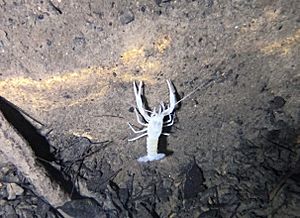Dougherty Plain cave crayfish facts for kids
Quick facts for kids Cambarus cryptodytes |
|
|---|---|
| Conservation status | |
| Scientific classification | |
| Kingdom: | |
| Phylum: | |
| Subphylum: | |
| Class: | |
| Order: | |
| Family: |
Cambaridae
|
| Genus: |
Cambarus
|
| Species: |
C. cryptodytes
|
| Binomial name | |
| Cambarus cryptodytes Hobbs, 1941
|
|
The Dougherty Plain cave crayfish (also called the Apalachicola cave crayfish) is a small, freshwater crayfish. It lives only in Florida and Georgia in the United States. This special crayfish lives underground. It is found in water connected to the Floridan aquifer, which is a huge underground water system.
What Does It Look Like?
The Dougherty Plain cave crayfish can grow to about 53 millimetres (2.1 in) long. That's about the length of your thumb! Its antennae are even longer, about twice its body length.
This crayfish is quite unique because it has no color. It looks almost see-through. Its eyes also have no pigment, so they don't really see. Its body is made of segments, like a suit of armor. It has a pair of thin claws (called chelae) that have small bumps on them. It also has long, thin legs. The part of its head called the rostrum is long and smooth, without any bumps or spikes.
Where Does It Live?
You can find the Dougherty Plain cave crayfish in springs, wells, and cave systems. These places are all part of a special karst limestone area called the Dougherty Plain. This region is in the Southeastern United States.
It has been found in a few specific places. In Georgia, it lives in Dougherty County and Decatur County. In Florida, it's found in Jackson County and Washington County. Scientists think it might also live in Mitchell County and Baker County in Georgia. These counties are located between the areas where the crayfish has already been found.
How Does It Live?
Scientists don't know a lot about the daily life of this cave crayfish. It probably eats whatever it can find. This means it's an omnivore and a scavenger. It might even eat the Georgia blind salamander (Haideotriton wallacei), which lives in the same underground areas.
This crayfish has a very slow metabolic rate. This means its body uses energy very slowly. This might be because there isn't much food available underground. Because of its slow metabolism, scientists believe it could live for twenty years or even longer!
Scientists have found male crayfish ready to reproduce between July and October. However, they haven't found any females carrying eggs. They also haven't found any young crayfish. This means there's still a lot to learn about how these crayfish reproduce.
Is It in Danger?
In 1996, the Dougherty Plain cave crayfish was listed as "Vulnerable" on the IUCN Red List of Threatened Species. This list helps track animals that might be in danger.
But then, scientists discovered that the crayfish lives in more places than they first thought. So, in 2010, its status was changed to "Least concern". This means it's not currently in great danger. It has a wide range and is common in the areas where it lives.
This crayfish can even live in water with low oxygen levels. This suggests it might be widespread in the underground aquifer, even in places that don't open to the surface.
However, there are still some potential threats. Taking too much water from the aquifer for human use could harm them. Also, pollution from pesticides and extra nutrients from farms could contaminate their water.



